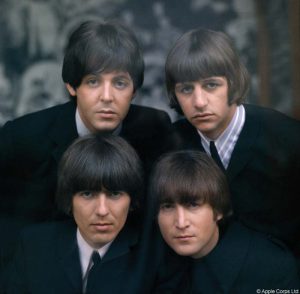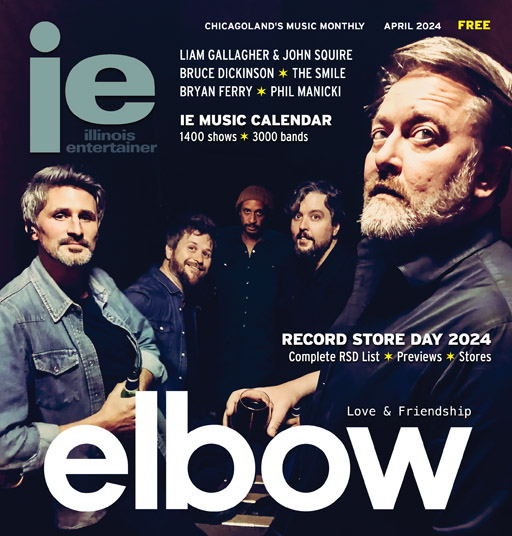Baling The Beatles
The Beatles Stereo Reissues

At the Entertainer, we do it for you. We suffered through some 14 albums of some obnoxious old band called The Beatles, who’ve plagued the universe with new versions of their old albums. The following are our results. Beware.
Please Please Me
There aren’t any statistics, but so much of the rock ‘n’ roll landscape is littered with classic debut albums people forget that Please Please Me is lacking. Granted, the long-form, artistic statement hadn’t been invented for pop music in ’63, but the tagline on the cover (“Love Me Do and 12 other songs”) isn’t far off. Only a fool, however, would be able to ignore the legendary, kamikaze versions of “I Saw Her Standing There” and “Twist And Shout,” which aren’t in need of any digital remastering but benefit from it nonetheless. Elsewhere the harmonies feel both clearer and colder, and the jangling chords jangle more. As debuts go, however, there’s no reason to start here.
— Steve Forstneger
With The Beatles
Though the cover shot is iconic (en-sured so when they retook it years later), Please Please Me‘s photos veer from touristy to lawyerly to, well, you explain the blown-up car. With The Beatles‘ art sees the label grasping the band’s iconography barely months later. The liner notes admit to trying to replicate the debut’s success, but the band make the curious move of staking out territory via covers and only once, with “Money,” cowing to formula. This set is still among the least necessary in their catalog, and the painstaking remastering does little to raise its profile. “Hold Me Tight” might actually suffer from it, and repeated listens remind you how a few, short steps in the other direction could’ve been disaster.
— S.F.
A Hard Day’s Night
It’s cool, especially if you grew up after John Lennon’s murder, to draw a line at Rubber Soul and dismiss the Beatlemania years. But you can’t ignore that chord. It announces this soundtrack album, it yells “Action!” at the Mirage in Las Vegas, and it goes by the unwieldy name of F add9. It’s symbolic of what The Beatles would become: something instantly recognizable but impervious to description. Slobbering hyperbole aside, if you had to start telling the band’s musical story somewhere, this might as well be it. The only album composed entirely of Lennon/McCartney credits, A Hard Day’s Night encapsulates early Beatles better than the 1962 – 1966 compilation. As such, the remastering passes by unnoticed, because the songs are that good, that uncompromised by how they were recorded. Urgency, tunefulness, hand-holding, slapping a hand away — the line between boy-band pap and self-assured artistry begins and ends here . . .
— S.F.
Beatles For Sale
. . . though some say that line gets bent on Beatles For Sale. Yammer all you want about “A Day In The Life,” this album’s first three tracks are when you first really grasp the Lennon/McCartney divide. The trio — all Lennon — didn’t fortell the whole band’s direction as much as his own, and “No Reply” and “I’m A Loser” bespeak a Blood On The Tracks hurt. Unfortunately, this steady beginning also makes For Sale something of a mess. “Eight Days A Week” is clearly the album’s focus, but, as the ensuing Help! would bear out, The Beatles were beyond it. The remastering is a lesson in elevating bits of percussion you never knew existed and you can envisage Lennon’s anger a bit more clearly, but, until Let It Be, it’s really the last time the band would let so many iffy tracks pass through the filter.
— S.F.
Help!
There is no greater Beatles song than “Help!” The latest version increases the volume without distorting the song further, and that chugging rhythm guitar almost sets the song ablaze the more it smokes. The harmonies are just as they were on Please Please Me, but they’re begging for an out, wed to a minor key that encapsulates the delirium of Beatlemania better than “A Hard Day’s Night” could. The rest of the album — there’ more? — is exactly the sort of thing Rubber Soul supporters hate to have to explain. “You’ve Got To Hide Your Love Away” grasps Donovan, and “Ticket To Ride” bows to the Maharishi. And then there’s “Yesterday,” which still confounds Macca bashers, even in light of the underrated Lennon prowler “You’re Going To Lose That Girl” and his perpetual affair with early rock, “Dizzy Miss Lizzy.”
— S.F.
Rubber Soul
Sgt. Pepper is the classic, Revolver the creative breakthrough, Abbey Road the triumphant coda, and Let It Be the sad end. So where does that leave the Rubber Soul? The Beatles’ sixth album is an often-overlooked gem, a magnetic, hypnotic hybrid of the band’s pop past and soon-to-emerge experimental and influential future. It is bulging with hits, including “In My Life,” “Michelle,” “Nowhere Man,” as well as “Drive My Car,” “Run For Your Life,” and “I’m Looking Through You.” But it still lacks immediate top-of-the-head status. With the new remastering, Rubber Soul rightfully blossoms sonically to become, perhaps, the best Beatles album you’ve never heard. As with all the new Beatle remasters, there is an exciting clarity, crispness, and heft to the sound, and with the defined stereo spilt of instruments and vocals on this album, even the casual listener will hear the difference. Most revealing here is how solid singers and masterful musicians The Beatles were. The band is always praised for the songwriting of Lennon and McCartney, but on Rubber Soul, the remastering reminds us of the artistry of George Harrison and the precision of Ringo Starr. For example, on the enigmatic “Norwegian Wood,” Harrison’s sitar now demands equal attention with Lennon’s previously dominating lyrical narrative. And you can’t help but notice Harrison’s quirky guitar pickings on “What Goes On.” Starr’s steady timekeeping and beat on “In My Life” now shares equal prominence with Lennon’s timeless vocal, and one of the best Beatles’ pure-pop moments, “You Won’t See Me,” gains new freshness as the sugary harmonies punch McCartney’s perfect lead vocal. The pre-hippie vibe of “The Word” is now a collaborative musical chant, and on the seductive “Girl,” Lennon’s husky, longing breaths spray spit on your face. Thanks to the overdue remastering, this album could be the most important discovery of The Beatles’ catalog.
— James Turano
Revolver
I guess if any artist deserves the fanfare and falderal of a complete remastering treatment, The Beatles — unquestionably the most important band in rock ‘n’ roll history — would be your band. Why’d they wait so long? Why do I now own crappy-sounding versions of many of these albums? And really, what’s to say about a remastered Beatles set from 43 years ago?
Revolver sure sounds good now. It sounds good in my car, on my computer, but it sounds really good on my home stereo. Great care was taken to clean the original analog tapes and dump it all down to ProTools to remaster each track, and you can hear it. A little extra guitar echo here and there on “Taxman,” more prominent swirly ringing on “Love To You,” and you can hear the space between the layers in Lennon’s “Tomorrow Never Knows.” Neat stuff. Try this: move the balance back and forth, right and left, on almost any song. Starr’s drums are always on the left and his cymbals are on the right. Isolating the sound like this will help you realize what a fucking monster of a bass player McCartney can be at times.
Curiously enough, Revolver is one of my least favorite Beatles albums, though it contains a couple favorites, especially “She Said She Said.” Now I have a better sounding version of it to shit-can down to an MP3 for my iPod . . .
— Michael C. Harris
Sgt. Pepper’s Lonely Hearts Club Band
Sgt. Pepper has taken a beating over the past several years. Despite being pretty much hailed as a ground-breaking concept album on its release in 1967, hindsight says it’s a dated collection of some of The Beatles’ most dynamic music (“A Day In The Life,” the title track, “Fixing A Hole”) yoked to their most self-indulgent and sub-standard (“Within You Without You,” “When I’m 64,” “Being For The Benefit Of Mr. Kite”) crap that rival the worst moments of Let It Be. Forty-two years later, it’s clear the Sarge is a victim of four decades of unrealistic expectations and critical blow-back. Yet it’s still a pretty good little record. Sonically, it’s impressive to hear the band’s first “mixed for stereo” album remastered for a new generation, especially when pulled into four measly tracks of 2-inch tape. McCartney’s bass is distinctly more pronounced and, yes, funky on “Lovely Rita” and “Fixing A Hole” and most of the record. Starr’s cymbals and snare drum snap like never heard before, and The Beatles’ impeccable harmonies are more in your face. After the “first” listen, Sgt. Pepper offers a ton of sonic “wow” moments. Enough to merit re-purchase? Go for it.
— John Vernon
Magical Mystery Tour
When pouring over The Beatles’ cannon, it’s more than apt to classify Magical Mystery Tour as the Rodney Dangerfield of their releases. Never mentioned in the same breath as the heavy-hitters — due to its affiliation with the ill-conceived film project and inclusion of previously released singles for the U.S. release — Tour nevertheless satisfies on every level. While it isn’t conceptual in the Sgt. Pepper vein or is as experimentally daring as “The White Album,” it stands as having arguably the best collection of pure songs of any effort. It also finds them at the apex of their psychedelic predilections with “Blue Jay Way” and “I Am The Walrus.” When all is said and done, how can any album that has “Walrus” on it not rock your world?
— Timothy Hiatt
The Beatles
There’s this funny bit in The Beatles’ Anthology DVD where McCartney is talking about the “White Album” and how some people have said in retrospect it was too disjointed, too long, too self-indulgent, etc. Sir Paul responds by looking into the camera with disgust, and saying: “Hey, it’s The Beatles’ ‘White Album” . . . Shut up!”
The layered guitars on this set’s tracks like “While My Guitar Gently Weeps” are rich and vibrant; the pounding drums of “Helter Skelter” sound like cannons, right up to the point where Starr shouts, “I got blisters on my fingas!”; and the lush vocals of “Happiness Is A Warm Gun” sound as though they are in your living room.
Musically, The Beatles was a shared solo album while still very much a band project. Starr made his songwriting debut (“Don’t Pass Me By”); McCartney gave us some of the band’s best rockers (“Back In The U.S.S.R.,” “Birthday”); Harrison came into his own as a brilliant songwriter (“While My Guitar Gently Weeps,” “Pig-gies,” “Savoy Truffle”); and Lennon simply offered some of the best songs he ever wrote “(Julia,” “Dear Prudence,” “Sexy Sadie,” “Cry Baby Cry”).
— Bruce Pilato
Yellow Submarine
So there’s Harrison’s “It’s All Too Much” freakout and “All Together Now,” a glorified drinking song. The only reason to buy the Yellow Submarine soundtrack is if it’s the only Beatles album you’ll own. Just so you can be that guy.
— Steve Forstneger
Abbey Road
Abbey Road is arguably The Beatles’ recording apogee — the band’s 12th and final release of an extraordinary six-plus-year run and, as with the first, last with all four members in the studio at the same time. So after 40 years’ familiarity via original vinyl and 22 years’ via CD remake, how does 2009’s much-ballyhooed, remastered icon stack up? Quite nicely. Indeed, it sounds like the ’90s recording it is; as if the four lovable mop tops of 1964 had just drunk from the fountain of youth and re-entered the studio yesterday. Vocal parts and individual playing (particularly McCartney’s and Starr’s) sparkle above an overall brighter, punchier-than-one-remembers group sound throughout. And while all the re-engineering of the original tapes didn’t end up in a fully remastered vinyl version leaves an “apples-to-apples” comparison between side twos (“Here Comes The Sun” through “Her Majesty”) still out of reach, there’s no denying the range and brilliance of Abbey Road‘s final 16 minutes, regardless of format.
— David C. Eldredge
Let It Be
As swan songs go, Let It Be disappoints because its genesis had so many different incarnations. The remastering of the disc allows for a thorough, overdue re-examination. Immediately apparent is the clairvoyant musical relationship between McCartney’s nimble basslines and Starr’s metronomic backbeats that occasionally give way to drum fills that now pop like fireworks.
The vocal interplay (specifically on “Two Of Us” and “Dig A Pony”) that volleys from Lennon to McCartney is notable in that it could easily have taken place in the Cavern Club and not in the basement of the Apple compound. And when it does get sent for a cup of tea, it’s replaced by some of Harrison’s cleanest, yet surprisingly unhinged guitar pyrotechnics.
Still, no amount of studio wizardry can salvage some of the lesser material. “Dig It” and “Maggie Mae” still sound tossed off, and even though Phil Spector’s production is relegated to window dressing, it still pollutes the simple, melodic beauty of “The Long And Winding Road.” But if the Fabs’ storied career taught us anything, it’s that nothing — inflated egos, psychotic producers, or messy breakups — could suffocate their ability to construct a timeless melody.
— Curt Baran
Past Masters
The bad news, in case you haven’t heard, is that these two discs of odds ‘n’ sods come packaged so tightly in a replica foldout LP cover that it’s all but impossible not to scratch them every time you slide them in or out. (At least vinyl came protected in paper or plastic sleeves.) The good news is that you needn’t slide these discs in or out at all to hear their contents. Originally left off The Beatles’ U.K. albums and released only on 45s or EPs, most of these 33 songs have nevertheless long been available on one side of the Atlantic or another on compilations with more user-friendly — and disc-friendly — packaging (1962-1966, 1967-1970, Rarities, 20 Greatest Hits, 1). Meanwhile, though only audio nerds will likely detect the audio superiority of these latest remasterings, average fans of various nationalities will easily notice the pointlessly extreme separation of the “wider stereo” versions of “Komm, Gib Mir Deine Hand” (“I Want To Hold Your Hand” in German) and “Sie Liebt Dich” (“She Loves You,” ditto) and wonder why we couldn’t have gotten, oh, I dunno, a spruced-up The Beatles At The Hollywood Bowl or some other genuine obscurities instead.
— Arsenio Orteza










I’m just happy that Phil Spector is finally doing hard time for his “Let It Be” production. This should be served concurrently with a sentence for what he tried to do to the Ramones “End of the Century”.
I’d have to disagree with your low rating on With The Beatles. Much of the material was from their Hamburg and Cavern shows, so what if they were covers? This was like capturing
the band live and in person. By this time, 1963, you couldn’t hear them in concert anyway, so why not get the next best thing? I would give it an 8 out of 10.
I must disagree also with your miscalculation. The early recordings were raw and with a live felling to them. The polished mark they leave behind is something that many LA productions could only hope to achieve. Your distain is astonishing. You must have been a Jack Jones fan.
I must say that for music journalists, your knowledge of the Beatles material is lacking and thus I cannot take your opinions seriously. Example- “Great care was taken to clean the original analog tapes and dump it all down to ProTools to remaster each track, and you can hear it. A little extra guitar echo here and there on “Taxman,”…” Only the master tapes were remastered. There was no remixing done and no effects added or taken away. Read one of the interviews with the men who did the work!